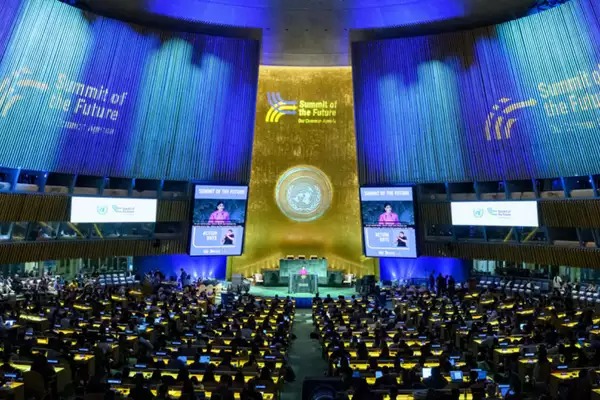The United Nations’ new “Pact for the Future” was adopted recently during the Summit of the Future at the UN General Assembly (UNGA).
Key Details of the Pact of the Future:
- This pact aims to reinvigorate the role of the UN in addressing global challenges, responding to criticisms, for prevention wars and hold violators of its charter accountable.
- The pact is described as a “landmark declaration” intended to create a better world for future generations.
- The pact encompasses critical themes such as peace and security, global governance, sustainable development, climate change, digital cooperation, human rights, and youth engagement.
- It outlines approximately 56 broad actions that member countries have committed to pursuing.
- This aims to ensure that U.N. institutions are responsive to contemporary global challenges, advocating for effective and capable, just, democratic, equitable, and financially stable system.
- It includes a pledge to move faster towards achieving the UN’s Sustainable Development Goals (SDGs) and the Paris Agreement commitments on climate change.
- It speaks of addressing the root causes of conflicts and accelerating commitments on human rights, including women’s rights.
- It also strives for tackling global hunger, achieve gender equality, promote a fair multilateral trading system, and protect people affected by humanitarian crises.
- Ongoing conflicts, climate change, national debt crises, and unregulated technological advancements highlighted the necessity for reform within the U.N. and international finance.
- UN Secretary-General highlighted the need to bring multilateralism back from the brink, urging nations to act together to achieve the pact’s goals.
Additionally, two annex documents are part of the pact:
- Global Digital Impact: Focuses on regulating artificial intelligence (AI).
- Declaration on Future Generations: Calls for decisions to secure the wellbeing of future generations.
Criticism:
- Russia, Iran, North Korea, Belarus, Syria, Nicaragua, and Eritrea, opposed the Pact for the Future, citing concerns on national sovereignty and the role of external entities in domestic affairs.
- Germany and Namibia (the facilitators) included only what was dictated by Western countries while ignoring Russia’s repeated requests for intergovernmental negotiations.
- The Republic of Congo, representing Africa’s 54 nations, and Mexico, rejected Russia’s proposed amendments.
- The Pact lacks clear, actionable steps and concrete mechanism to achieve objectives like ending hunger, achieving gender equality, and promoting disarmament of nuclear weapons.
- The UN Security Council (UNSC) reform remains a contentious issue, with developing countries pushing for better representation.
- It provides no clear path to speeding up long-standing demands for reforms like international financial architecture and details on prevention of an arms race in outer space.
Ref: Source
| UPSC IAS Preparation Resources | |
| Current Affairs Analysis | Topperspedia |
| GS Shots | Simply Explained |
| Daily Flash Cards | Daily Quiz |
Frequently Asked Question:
What is the “Pact for the Future”?
The “Pact for the Future” is a landmark agreement adopted by the United Nations General Assembly for broad actions on global governance, sustainable development, peace, security, climate change, etc.
Why was the pact adopted?
Issues such as wars, climate change, and unregulated technological advancements underscored the urgency of establishing a more effective multilateral framework.
How many actions does the pact include?
The pact includes approximately 56 broad actions that member countries have committed to implement, addressing various global challenges and opportunities.
What are the main themes covered by the pact?
The main themes include Peace and security, Global governance, Sustainable development, Climate change, Digital cooperation, Human rights, Gender equality, and Youth engagement.



